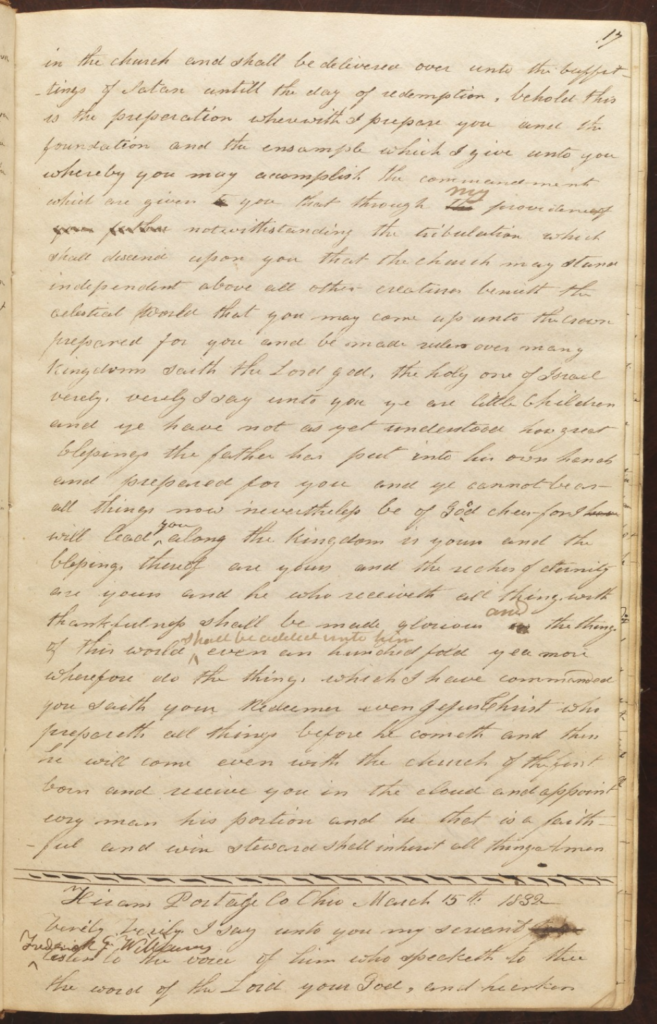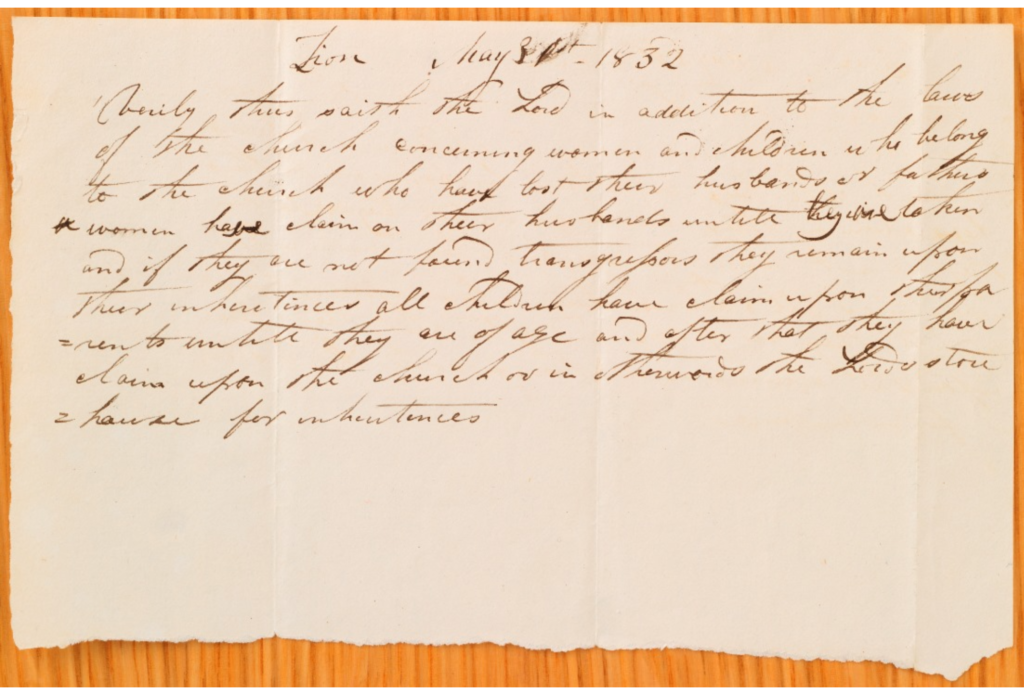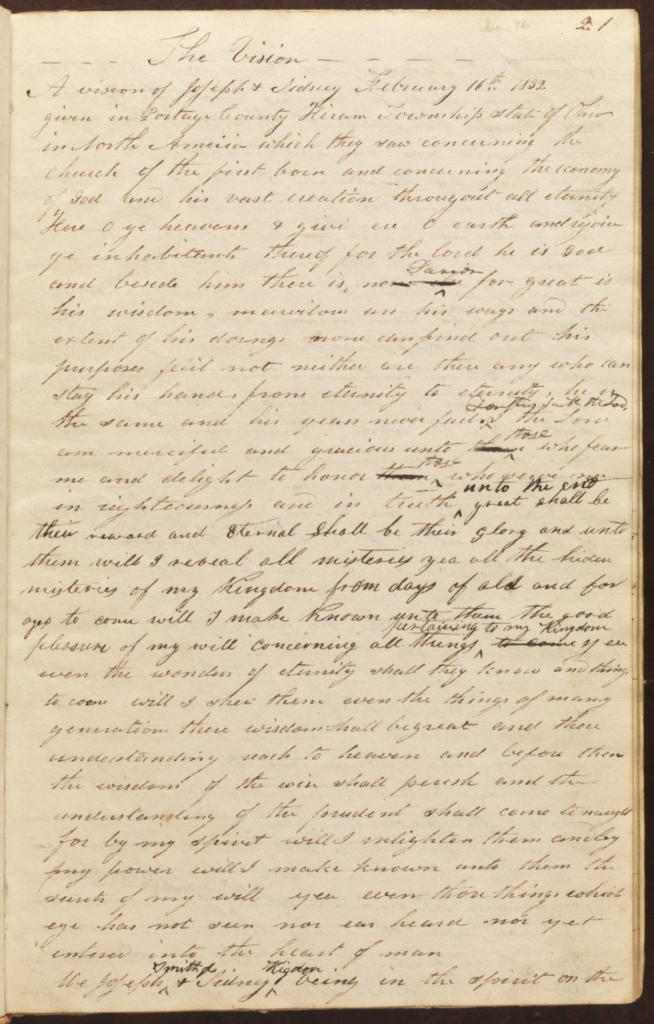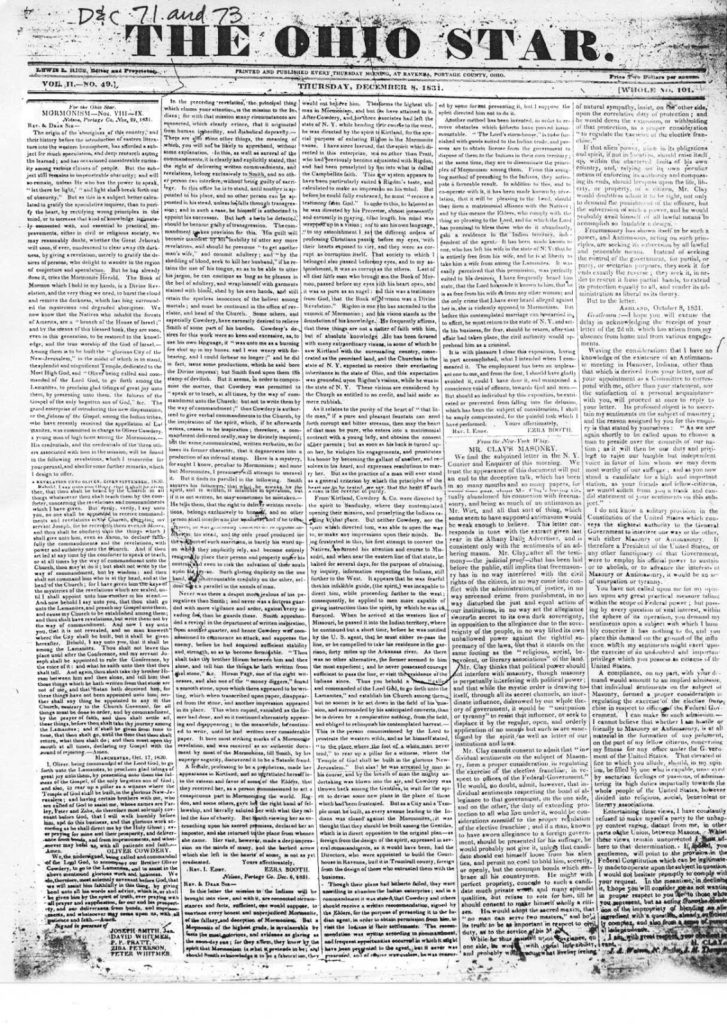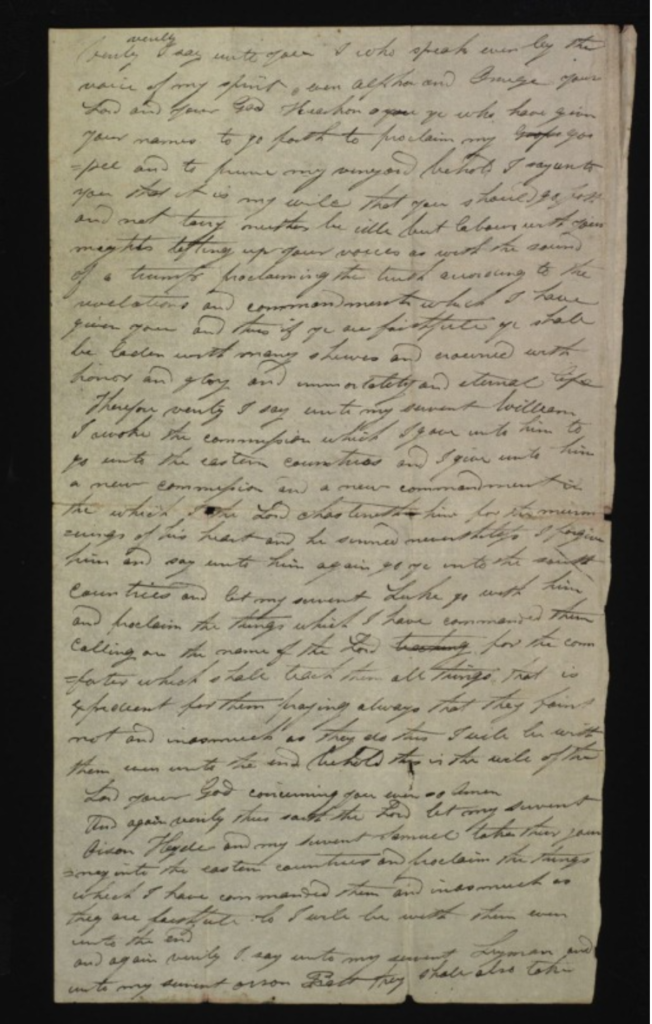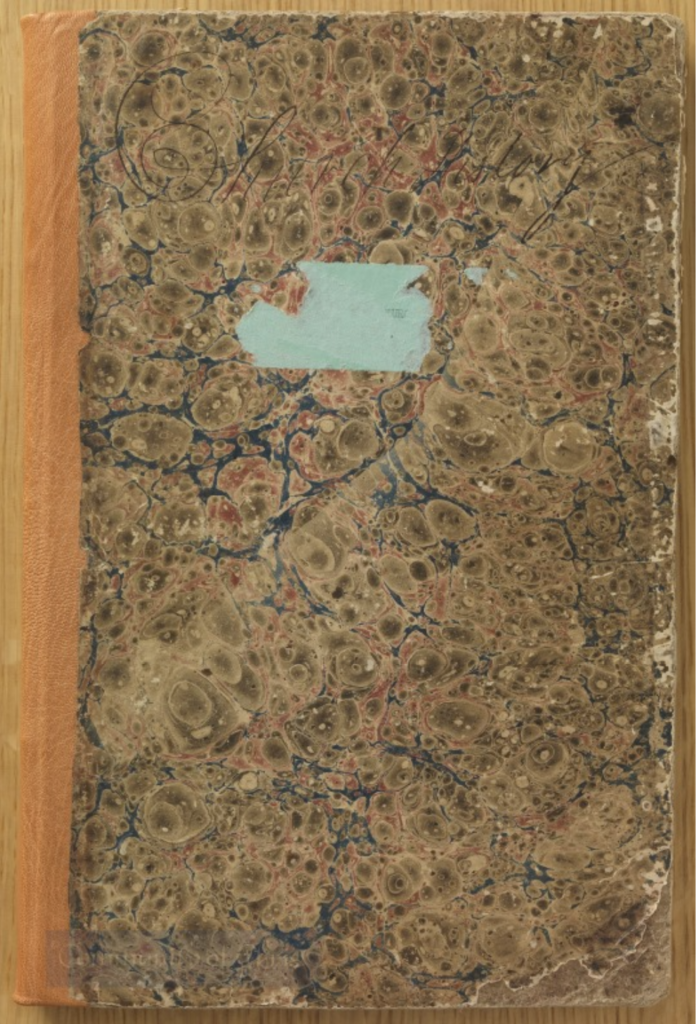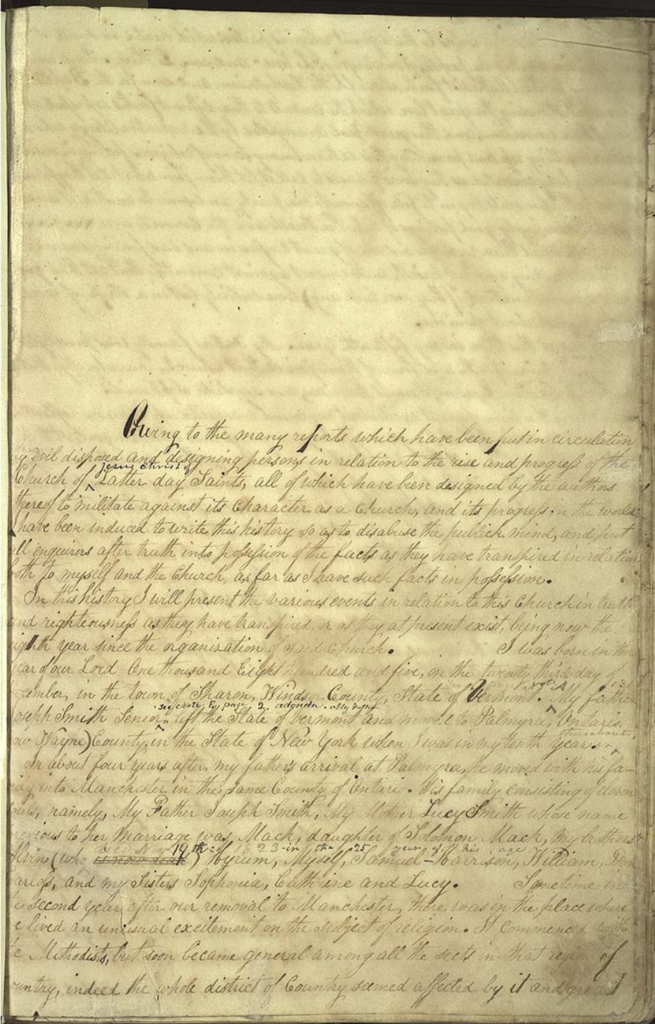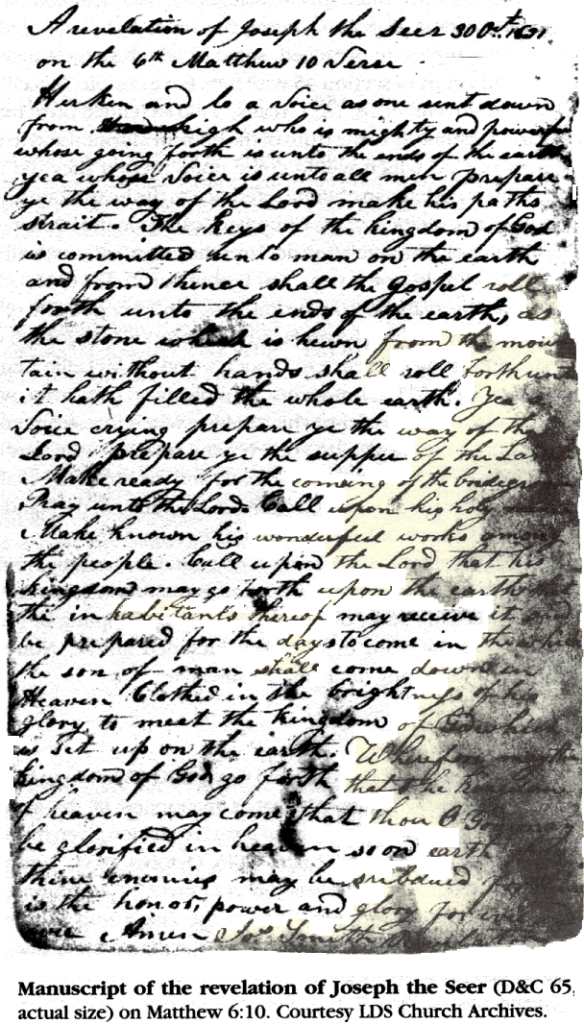Section 85
The leaders of the church in Missouri grew troubled. Saints were gathering there by the hundreds. Relatively few of them were obeying the law of consecration when they did. “Have you all fulfilled the law of the church,” William Phelps wrote to them in the church’s newspaper, “which saith: Behold thou shalt consecrate all thy properties, that which thou hast, unto me, with a covenant and a deed which cannot be broken?” (see section 42).[1]
In Ohio, Joseph learned by “the still small voice” that leaders in Missouri were wondering what to do. He sought and received a revealed answer, section 85, which he sent to them.[2] It clarifies the duty of the Lord’s clerk to keep a history of righteousness and unrighteousness in Zion, including accurate records “of all those who consecrate properties, and receive inheritances legally from the bishop.” Those that do not receive their inheritance by living the law of consecration are to be excluded from the church record referred to as the “book of the law of God.”
Verse 7 prophesies that the Lord will send someone to arrange inheritances for those whose names are recorded in the book, but those who are not in the book will receive no inheritance in Zion. Verse 8 prophesies that those who steady the ark (go beyond their assigned role in building Zion) will be smitten.
Joseph purchased his first journal on the very day this revelation was given, “for the purpose,” he wrote, “to keep a minute account of all things that come under my observation.”[3] At about this same time, Joseph began writing his history, recording his letters, and minutes of church council meetings. He knew, as John the Revelator had prophesied, that the mankind would be judged by records of their works kept on earth (Revelation 20:12, D&C 128:6-8), and Joseph tried to document his own “manner of life” (D&C 85:2).
Later, in 1841, Joseph began another journal, the Book of the Law of the Lord, a title he derived from D&C 85. Joseph appointed Willard Richards as “Recorder for the Temple, and the Scribe for the private office of the President.” Willard became what Section 82 calls the “Lord’s clerk,” filling the duties described in the revelation. He recorded historical entries and donations in the Book of the Law of the Lord.[4] In 1842, while preparing to leave for the East, Richards gave the Book to William Clayton, whom Joseph appointed as Temple Recorder, with a commission to fulfill the duties named in Section 82.[5]
These recorders carefully kept track of consecration. They recorded the deeds and donations of those who freely offered their whole souls to the Lord’s work. Joseph recorded a tribute to his wife Emma, to bishop Newel Whitney, to his brother Hyrum and many others. ‘The names of the faithful are what I wish to record in this place.” He recorded “the virtues and the good qualifications and characteristics of the faithful few,” as he called them, but also noted that “there are a numerous host of faithful souls, whose names I could wish to record in the Book of the Law of the Lord.”[6]
I’m sometimes asked when the Lord will require us to live the law of consecration. The answer is never. It never has been coercive and never will be. Section 85 clarifies that church leaders should simply keep track of who consecrates but not encroach on individual agency to obey or disobey. The Lord will judgment as he deems best. The law is quietly kept by many people, and their names are recorded in appropriate places. The faithful whose names and deeds are documented will receive inheritances in Zion. Those “whose names are not found written in the book of the law . . . shall not find an inheritance among the saints of the Most High” (D&C 82:7, 11).
Section 86
With Christianity in apostasy and no living prophets, Protestant reformers retreated to the relative safety of the Bible, the known word of God. Some went so far as to declare, though the Bible never does, that it was all sufficient and alone sufficient for salvation. Joseph faced the same fears and frustrations resulting from apostasy, but he took a different approach to the Bible. He “reflected again and again” on its often repeated injunction to ask and receive, seek and find, knock and the door will open (Joseph Smith—History, 12).
Joseph continually worked at understanding the Bible better and better, and making it possible for us to do so too. He had been over the parables in Matthew 13 in the spring of 1831, but he revised his own revision a year and a half later. His journal for 6 December 1832 says he spent the day “translating and received a revelation explaining the Parable [of] the wheat and the tears.”[1]
Section 86 defines and evokes powerful symbols to explain a parable about how the gospel spread, how apostasy followed and “drove the church into the wilderness” (D&C 86:3), and how the Lord nevertheless protected and preserved his people and will cause the gospel to flourish again. The main analogy of the parable is a field in which the apostles have planted wheat but Satan has sewn tares. The question for Joseph Smith and Latter-day Saints is, how should the field be harvested? The version in Matthew 13 says to let the wheat and the tares “grow together until the harvest: and in the time of harvest I will say to the reapers, Gather ye together first the tares, and bind them in bundles to burn them: but gather the wheat into my barn” (Matthew 13:30). Importantly, Section 86 reverses the order of the harvest: “Let the wheat and the tares grow together until the harvest is fully ripe; then ye shall first gather out the wheat from among the tares, and after the gathering of the wheat, behold and lo, the tares are bound in bundles, and the field remaineth to be burned (D&C 86:7, cross reference D&C 64:24). In his new translation, Joseph revised Matthew 13 according to what he learned from the revelation (JST Matthew 13:29).
All that is preliminary to the Lord’s main point in Section 86. His intent in the revelation is to explain how, despite apostasy, the priesthood has returned to its lawful heirs, and they are commissioned to harvest the wheat planted by the original apostles. Notice how the Lord develops this point with the four consecutive Therefores that begin verses 7, 8, 10, and 11.
The difference between Joseph’s way of reading the Bible and the dominant way of his time and place is crucial. For many people, the Bible is “a sealed book,” as popular Methodist preacher of Joseph’s day described it, lamenting that he did not live “in the days of the prophets or apostles, that I could have sure guides.”[2] Joseph’s revelations open the Bible. Consider how profound it is that in section 86 the Lord explains his own parable to Latter-day Saints. Is there any reason why He would not? Could not?
Section 86 revises and expands the biblical record. The fact that it came as Joseph was revising his previous revision is, itself, revealing. Joseph never felt finished with the work of unlocking the scriptures. One of his great contributions to us is his example of reading for and receiving revelations.
Section 87
Section 87 came during a Constitutional crisis. Congress had passed tax laws that favored northern factories over southern planters. So a South Carolina convention “unilaterally nullified the tariff and forbade its collection. President Andrew Jackson, refusing to acknowledge this assertion of state power, called out troops. By Christmas 1832, a military confrontation appeared imminent.”[1]
Latter-day Saints and other Christians viewed these events (along with a plague in India and a nearly global outbreak of cholera) in eschatological terms, meaning they thought the end of the world would come soon.
At least that’s how it looked to Joseph Smith and others late in 1832. Wars and rumors of wars, desolating sicknesses and desolating scourges were in the news.[2] Joseph asked for and received a revelation about what was to come. It said that wars–plural–would begin shortly with South Carolina’s rebellion, then continue until wars had gone global and resulted in “a full end of all nations” (D&C 87:6). The revelation foresaw slave rebellions and the uprising of “remnants” vexing the Gentiles, which Joseph and the early Saints interpreted in Book of Mormon terms to mean descendants of Lehi irritating the unrepentant (Mormon 7:1-10, 3 Nephi 10, D&C 19:27).[3]
Section 87 is mainly descriptive, not prescriptive. The first seven verses describe what God knows will happen because people reject His laws and His love. It is not about what He wants to happen, or what would happen if people obeyed His laws and reflected His love. It describes unfathomable violence by which the inhabitants of the earth “feel the wrath, and indignation, and chastening hand of an Almighty God” whom they have rejected. Given the impending eschaton, the prescriptive point in the last verse is “stand ye in holy places, and be not moved” (D&C 87:8).
Is that a command to be passive? Does it mean we should be bystanders or immobilized by fear? I think it means something like, take a stand for holiness and don’t get pushed around. I interpret it as a command to take an immovable stand for the laws and love of God in a world descending into self-destruction. The otherwise depressing revelation ends with good news for those who take such a stand: The day of the Lord–the eschaton–comes quickly (D&C 87:8).
Joseph Smith may have looked foolish to some when the crisis blew over. Civil war didn’t come. It didn’t start with the rebellion of South Carolina, nor result in death and misery, or global warfare, or the end of nations. Well, at least not right away, as Joseph and others probably expected.
The eschaton never seems to happen as expected. That’s the story of Christian eschatology in a nutshell. Since the days of Paul at least, Christians have been expecting the end of the world any day. Every generation of Christians has waited for the end times, and there are always some Christians somewhere who are sure that it’s coming very, very soon.
Early Latter-day Saints were like that, though not quite as much as the followers of William Miller (1782-1849). He was a generation older than Joseph Smith. He was a Baptist, then a Deist, but the combination of having his life miraculously saved in the War of 1812 and the deaths of loved ones led him to conversion to Jesus Christ, and he renewed his Baptist faith. He longed for Jesus’ return to end wars and death. Like me, William Miller didn’t have the knowledge or skills or the revelation necessary to read and understand apocalyptic parts of the Bible in context. So he made some assumptions that led him to interpret Daniel 8:14 to mean that the Savior would return sometime between March 21, 1843 and a year later.
Some of William Miller’s followers got even more specific
They narrowed the day of the Savior’s Second Coming to April 3, 1843. They were not the only ones interested as that day approached. Latter-day Saints were also looking forward to the Savior’s Second Coming, studying the prophecies, trying to discern the signs of the times, as Christians had been doing for nearly two millennia.
So It was no wonder that on Sunday April 2, 1843 the subject came among the saints. Joseph told them, “I prophecy in the Name of the Lord God that the commenceme[n]t of bloodshed as preparat[o]ry to the coming of the son of man. will commenc[e] in South Carolina.— (it probably may arise through the slave trade.)— this the a voice declard to me. while I was praying earne[s]tly on the subje[c]t 25 December 1832. I earnestly desird to know concern[in]g the coming of the Son of Man & prayed. when— a voice said to me, Joseph, my, son, if thou livest until thou art 85 years old thou shalt see the facce of the son of man. therefore let this suffice & trouble me no more on this matter.[4]
The next day was April 3, 1843. It turned out not to be the eschaton. Joseph’s journal entry takes a poke at Miller and his followers: “tis too. pleas[a]nt. for false prophets.” A few days later on April 6, 1843, Joseph again told his experience a decade earlyer of praying to know when the Savior’s Second Coming would be, and this time he added how he had decided to interpret the Lord’s intentionally vague revelation: “. . . were I going to prophecy. I would procpesy [prophesy] the end will not come in 1844. or 5— or 6. or 40 years more [p. [72]] there are those of the rising generation who shall not taste death till christ come. <I was once praying earnestly upon this subject. and a voice said unto me.> My son, if thou livest till thou art 85 years of age, thou shalt see the face of the son of man. . . . <I was left to draw my own conclusions concerni[n]g this &,> I took the liberty to conclude that if I did live till that time Jesus <he> would make his appearance.— <but I do not say whether he will make his appeara[n]ce, or I shall go where he is.—> I prophecy in the name of the Lord God.— & let it be written. <that the> Son of Man will not come in the heavns till I am 85. years old 48 years hence or about 1890.—” (cross ref. D&C 130:14-17)
Look at the way Joseph read his own revelations in the context of his culture’s eschatology. He accurately prophesied the American Civil War, but he didn’t fully understand his prophecy. When he received the revelation in 1832, as South Carolina was threatening secession, he assumed, as almost all Christians have done, that the Savior’s Second Coming would be soon. Then in 1843 Joseph specifically noted the difference between what the Lord revealed and what he, Joseph, interpreted it to mean:
The Lord’s revelation: “Joseph, my, son, if thou livest until thou art 85 years old thou shalt see the face of the son of man. therefore let this suffice & trouble me no more on this matter.”
Joseph’s interpretation: “I was left to draw my own conclusions concerni[n]g this &,> I took the liberty to conclude that if I did live till that time Jesus <he> would make his appearance.— <but I do not say whether he will make his appeara[n]ce, or I shall go where he is.—> I prophecy in the name of the Lord God.— & let it be written. <that the> Son of Man will not come in the heavns till I am 85. years old 48 years hence or about 1890.—”
This is a terrific way to show that Joseph Smith was a true prophet of God and a frontier farmer in the antebellum (pre Civil War) United States. That means that he knew things from God that no one else could, and that he understood them as most everyone else in his time and place would.
Sometimes Joseph didn’t understand right away how to interpret the Lord’s revelations. He referred to his Christmas 1832 revelation occasionally but never published it during his lifetime. Latter-day Saints began to pay attention to it in the 1850s as the American Civil War loomed. Then, in 1861, when it began to be fulfilled to the letter, a Philadelphia newspaper reprinted the revelation and asked, “Have we not had a prophet among us?”[5]
Section 85 notes
[1] “To the Saints,” The Evening and the Morning Star, Nov. 1832, [6].
[2] “Letter to William W. Phelps, 27 November 1832,” p. 1, The Joseph Smith Papers, accessed July 7, 2020, https://www.josephsmithpapers.org/paper-summary/letter-to-william-w-phelps-27-november-1832/1.
[3] Joseph Smith, Book for Record, Church History Library, Salt Lake City, published in Dean C. Jessee, editor, The Papers of Joseph Smith: Journal, 1832-1842 (Salt Lake City: Deseret, 1992), 2.
[4] Book of the Law of the Lord, 26, Church History Library, Salt Lake City.
[5] William Clayton, “History of the Nauvoo Temple,” manuscript, Church History Library, Salt Lake City.
[6] Book of the Law of the Lord, 164, 179, Church History Library, Salt Lake City.
Section 86 notes
[1] “Journal, 1832–1834,” p. 4, The Joseph Smith Papers, accessed July 7, 2020, https://www.josephsmithpapers.org/paper-summary/journal-1832-1834/5.
[2] Lorenzo Dow, The Dealings of God, Man, and the Devil as Exemplified in the Life, Experience, and Travels of Lorenzo Dow (New York: Cornish, Lamport & Company, 1850), 10.
Section 87 notes
[1] Bushman, Rough Stone Rolling, 191.
[2] “Signs of the Times,” The Evening and the Morning Star 1:8 [January 1833], 62.
[3] “Revelation, 25 December 1832 [D&C 87],” p. 32, The Joseph Smith Papers, accessed June 7, 2020, https://www.josephsmithpapers.org/paper-summary/revelation-25-december-1832-dc-87/1.
[4] “Instruction, 2 April 1843, as Reported by Willard Richards,” p. [39], The Joseph Smith Papers, accessed June 7, 2020, https://www.josephsmithpapers.org/paper-summary/instruction-2-april-1843-as-reported-by-willard-richards/3.
[5] “A Mormon Prophecy,” Philadelphia Sunday Mercury, 5 May 1861, reprinted in Robert J. Woodford, The historical development of the Doctrine and Covenants, 3 volumes (PhD dissertation, Brigham Young University, 1974), 2:1110.

